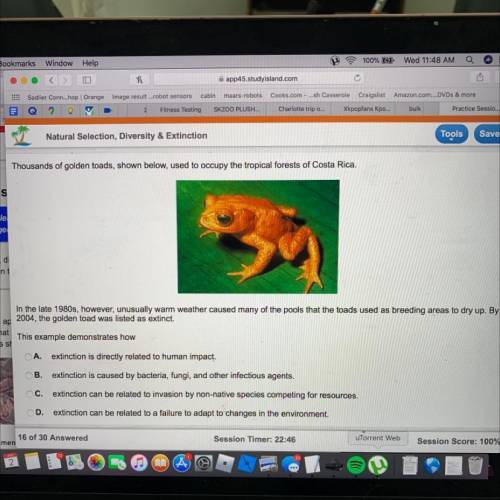
Biology, 02.06.2021 19:00 rainbowstyles4461
HELP
Thousands of golden toads, shown below, used to occupy the tropical forests of Costa Rica.
In the late 1980s, however, unusually warm weather caused many of the pools that the toads used as breeding areas to dry up. By
2004, the golden toad was listed as extinct.
This example demonstrates how
A. extinction is directly related to human impact.
B. extinction is caused by bacteria, fungi, and other infectious agents.
C. extinction can be related to invasion by non-native species competing for resources.
D. extinction can be related to a failure to adapt to changes in the environment.


Answers: 2


Other questions on the subject: Biology

Biology, 22.06.2019 11:00, ThetPerson
Examine the air pressure map. which type of line is shown on the map?
Answers: 1

Biology, 22.06.2019 11:20, maddiecrouch21
Drag each label to the correct location on the chart. match the function to the type of tissue
Answers: 2


Biology, 23.06.2019 00:30, booooooooooo37
Will mark brainliest! 1.) jan’s sister and mother have both had breast cancer. she is wondering if she should undergo genetic testing to check for a mutation of the brca1 gene. a mutation in the brca1 gene is commonly associated with, but not guaranteed to cause, breast cancer. the presence of a mutation increases a patient’s chances of getting breast cancer to about 85 percent, compared to a 13 percent risk in the general population. costs may vary, but most labs charge patients or their insurance companies less than $3,000 to sequence the brca1 to look for mutations. do you think that jan should undergo genetic sequencing? explain your answer. (2 points) what are potential pros and cons of having such tests done? (5 points) describe how the availability of genetic sequencing can affect the frequency of genetic diseases in individuals and populations. (3 points) 2.) scientists have developed genetically engineered plants that are pest-resistant. by adding genes to the plant’s dna, they become toxic to insects (but not to plants or animals). this means that these plants may not need to be sprayed with pesticides to ward off the insects. would you be willing to eat these genetically altered crops? explain your answer. (5 points) what are some possible impacts (positive or negative) of this genetically engineered plant on the environment, society, and individuals? (5 points)
Answers: 2
You know the right answer?
HELP
Thousands of golden toads, shown below, used to occupy the tropical forests of Costa Rica.
Questions in other subjects:


Mathematics, 09.04.2021 19:10






Business, 09.04.2021 19:10




